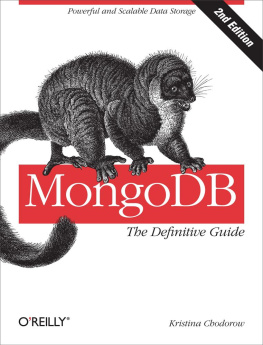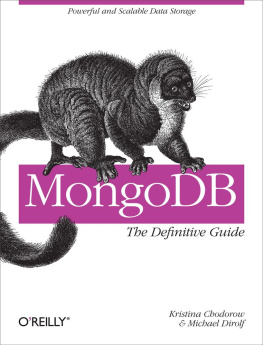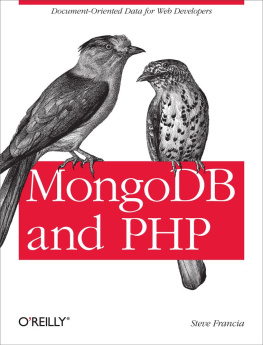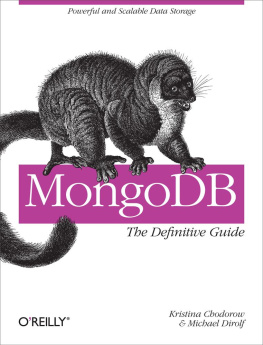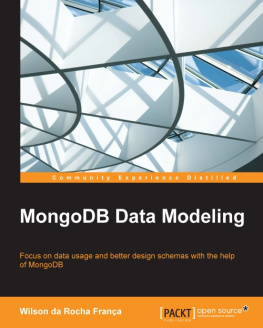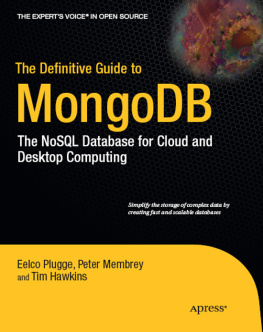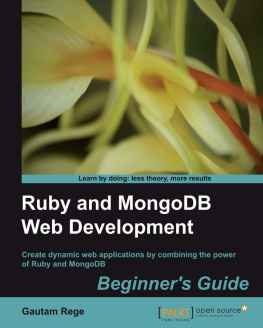Kyle Banker - MongoDB in Action: Covers MongoDB version 3.0
Here you can read online Kyle Banker - MongoDB in Action: Covers MongoDB version 3.0 full text of the book (entire story) in english for free. Download pdf and epub, get meaning, cover and reviews about this ebook. year: 2016, publisher: Manning Publications, genre: Home and family. Description of the work, (preface) as well as reviews are available. Best literature library LitArk.com created for fans of good reading and offers a wide selection of genres:
Romance novel
Science fiction
Adventure
Detective
Science
History
Home and family
Prose
Art
Politics
Computer
Non-fiction
Religion
Business
Children
Humor
Choose a favorite category and find really read worthwhile books. Enjoy immersion in the world of imagination, feel the emotions of the characters or learn something new for yourself, make an fascinating discovery.
- Book:MongoDB in Action: Covers MongoDB version 3.0
- Author:
- Publisher:Manning Publications
- Genre:
- Year:2016
- Rating:5 / 5
- Favourites:Add to favourites
- Your mark:
MongoDB in Action: Covers MongoDB version 3.0: summary, description and annotation
We offer to read an annotation, description, summary or preface (depends on what the author of the book "MongoDB in Action: Covers MongoDB version 3.0" wrote himself). If you haven't found the necessary information about the book — write in the comments, we will try to find it.
Summary
MongoDB in Action, Second Edition is a completely revised and updated version. It introduces MongoDB 3.0 and the document-oriented database model. This perfectly paced book gives you both the big picture youll need as a developer and enough low-level detail to satisfy system engineers.Purchase of the print book includes a free eBook in PDF, Kindle, and ePub formats from Manning Publications.
About the Technology
This document-oriented database was built for high availability, supports rich, dynamic schemas, and lets you easily distribute data across multiple servers. MongoDB 3.0 is flexible, scalable, and very fast, even with big data loads.About the Book
MongoDB in Action, Second Edition is a completely revised and updated version. It introduces MongoDB 3.0 and the document-oriented database model. This perfectly paced book gives you both the big picture youll need as a developer and enough low-level detail to satisfy system engineers. Lots of examples will help you develop confidence in the crucial area of data modeling. Youll also love the deep explanations of each feature, including replication, auto-sharding, and deployment.Whats Inside
About the Reader
Written for developers. No previous MongoDB or NoSQL experience is assumed.
About the Authors
After working at MongoDB, Kyle Banker is now at a startup. Peter Bakkum is a developer with MongoDB expertise. Shaun Verch has worked on the core server team at MongoDB. A Genentech engineer, Doug Garrett is one of the winners of the MongoDB Innovation Award for Analytics. A software architect, Tim Hawkins has led search engineering at Yahoo Europe. Technical Contributor: Wouter Thielen. Technical Editor: Mihalis Tsoukalos.
Table of Contents
- PART 1 GETTING STARTED
- A database for the modern web
- MongoDB through the JavaScript shell
- Writing programs using MongoDB PART 2 APPLICATION DEVELOPMENT IN MONGODB
- Document-oriented data
- Constructing queries
- Aggregation
- Updates, atomic operations, and deletes PART 3 MONGODB MASTERY
- Indexing and query optimization
- Text search
- WiredTiger and pluggable storage
- Replication
- Scaling your system with sharding
- Deployment and administration
Kyle Banker: author's other books
Who wrote MongoDB in Action: Covers MongoDB version 3.0? Find out the surname, the name of the author of the book and a list of all author's works by series.


